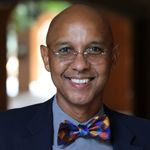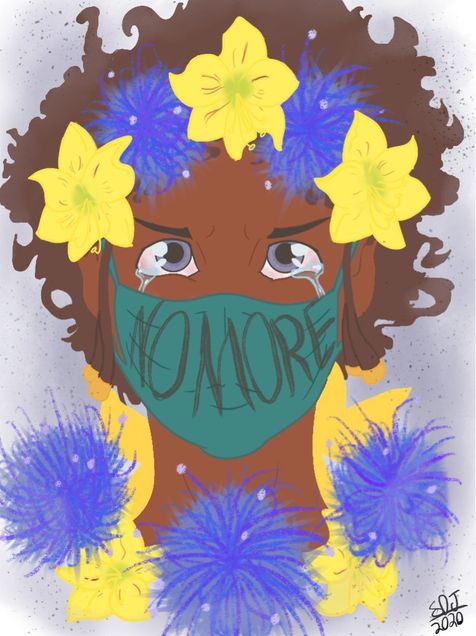The Pandemic of Racism
This article was originally published in focus magazine, the annual scholarly publication of the BU School of Theology, in May 2021. The full magazine is posted here and this article can be found on page 31.
One family navigates a year, amid a lifetime, of racist violence
By Ronald Angelo Johnson (STH’06)

In late May 2020, my wife, Colette, and I sat on our balcony amid the Texas twilight and absorbed the news that the Minneapolis police had murdered George Floyd. A rapt silence fell over us as we conjured images of the Black man, about our age, being brazenly suffocated by a white American police officer. One of us murmured, “Damn. Another one.” The other sighed an “amen.” The mild expletive expressed our rage over the senseless, repeated killing of our sisters and brothers. The breathy endorsement, a common refrain across Black America, presaged that more Black people would die at the hands of sworn protectors of the peace. Left unacknowledged was the grim fear held by many Black people: That could be me or someone I love.
Across the year, as ubiquitous suffering from the COVID-19 pandemic offered Americans of all backgrounds a comparable “it could be me” feeling, Black Americans endured the personal and communal ravages of what scholars like Ibram X. Kendi—BU’s Andrew W. Mellon Professor in the Humanities and founding director of Boston University’s Center for Antiracist Research—call “the pandemic of racism.”1 According to the American Psychological Association, “Racism is associated with a host of psychological consequences, including depression, anxiety and other serious, sometimes debilitating conditions, including post-traumatic stress disorder…. The impact of these repeated horrific incidents is inflicting trauma on the broader African American community.”2 Honestly, it has been exhausting to be Black in the United States over recent years, as government officials normalized casual racism and grand juries refused to indict murderous cops. Gospel great Mahalia Jackson melodiously asked, “How I got over?”3 Taking a moment to “look back and wonder,”4 the Johnson family endured the anxieties of the racism pandemic through a renewed commitment to the Black Church and individual efforts of antiracist activism.
***
My faith in God was shaken to its core in 2016, after the ascendance of a racist, misogynistic, xenophobic political campaign evoked a deafening silence from our church. My time at Boston University’s School of Theology had provided the intellectual and relational foundation that informed and nursed my spiritual grief. I eventually understood my experience as “a dark night,” from the St. John of the Cross poem we had read in seminary.5 In a desperate search for something “real,” I found purchase in the writings of Dietrich Bonhoeffer, to which Wesley Wildman’s theology class had introduced me. An STH classmate offered relentless friendship as I trekked along the path of unbelief. I emerged from a state of deep spiritual despair with a new and profound appreciation of koinonia, Christian fellowship with God and with each other.
Our family united with Ebenezer Baptist Church in Austin, Texas, a community of Black Christian believers whose religious raison d’être, like ours, stems from the theology of Martin Luther King, Jr. (GRS’55, Hon.’59). In his first book, Stride Toward Freedom, which I assign to US history freshmen, King proposed, “He who accepts evil without protesting against it is really cooperating with it…a righteous man has no alternative but to refuse to cooperate with an evil system.”6 The Ebenezer community seeks social justice through love-inspired resistance to systemic racism. As a Black family living in an incessant pandemic of racism, our spiritual resilience is replenished through communion within the Black Church. My research illustrates the roots of the Black Church in early African Protestantism, a determined effort to establish churches in open contrast to racist, white Christian theology, as Black Christians “identified their movement with God’s mercy and the history of deliverance of God’s people from slavery.”7
Worship at Ebenezer offers racial and spiritual affirmation through our collective disgust at the countless microaggressions endured by our community. We remember in prayer the names of the fallen, including Sandra Bland, Jonathan Price, and Eric Garner, because, in a very real sense, they are members of our congregation. Scholar Michelle Wright employs the particle physics principle of superposition to explain the multidimensionality that intersects Blackness in the African Diaspora across space-time.8 As Black people who experience tragic deaths across our community, we understand the fallen could be us, and we accept that we could be them.
***
Black people in the United States exist in what W.E.B. Du Bois termed “double consciousness, this sense of always looking at one’s self through the eyes of others.”9 It is important for Black people to understand who we are and how others perceive us. My son, RJ, does not enjoy “the talk,” difficult conversations about the dangers white American (mis)conceptions can pose to the lives of Black adolescents like Emmett Till and Tamir Rice. RJ is a six-foot, two-inch teenager and will be viewed as a threat despite his genial demeanor. We must teach him to identify the perils of others’ implicit biases. Social activism during the pandemic by Black NBA players bolstered RJ’s resilience. Their “cool” stance against racism inspired him to resist damaging language and practices through Instagram.
Colette and I, like many Black professionals, continue to seek acceptance for our family as full members in American society. She took to Facebook during the pandemic to engage our neighbors in more direct discussions about race. After the murder of Ahmaud Arbery, she expressed, “My son jogs every morning. I feel a sense of anxiousness until he comes home. My heart goes out to Ahmaud Arbery’s mother. Something must change.” On the birthday of Breonna Taylor, she posted, “I cannot fully express the pain and sorrow felt, coupled with my own imminent fear for my daughter, my son, and my husband.”

After the killing of George Floyd, our teenage daughter, Soleil, resisted racism through expressive art. She sketched a tearful Black girl adorned with flowers, wearing a mask with the words “No More.” Ebenezer posted the sketch during a virtual program to discuss racial justice. Soleil explained, “I want to be able to walk in my own neighborhood and actually feel safe. I don’t want to fear for my life every time I see a police car. My heart aches with every injustice that steals another son or daughter from this world.” Referring to the flowers in the sketch, she described, “Amaryllis signifies determination. Jasione signifies justice. We need both to grow as a nation.”
Soon after our balcony discussion of George Floyd’s murder, I penned an op-ed discussing “a culture of racism responsible for a jarring disruption of my childhood innocence.”10 My father endured racist, emasculating treatment and empowered me to become a first generation college graduate. Racism persists. Therefore, the Johnson family will continue to have “the talk.” We have no universal answers about stopping the pandemic of racism. Our acts of resistance are riddled with fear and sadness. But, we endure together. Resilience against racism is our history, our theology, and our way of life.
—-
1. Ibram X. Kendi, “Why Don’t We Know Who the Coronavirus Victims Are?” The Atlantic (theatlantic.com/ideas/ archive/2020/04/stop-lookingaway-race-covid-19-victims/ 609250). April 1, 2020.
2. “‘We Are Living in a Racism Pandemic,’ Says APA President,” American Psychological Association (apa.org/news/press/ releases/2020/05/racismpandemic). May 29, 2020.
3. Mahalia Jackson, “How I Got Over,” Columbia, 1976.
4. Ibid.
5. St. John of the Cross, Dark Night of the Soul, Third Revised Edition (New York: Image Books, 1959), 13.
6. Martin Luther King, Jr., Stride Toward Freedom: The Montgomery Story (New York: Harper & Brothers, 1958), 51.
7. Ronald Angelo Johnson, “Africans and Immigrants: Haitian Contributions to the African Protestant Movement in Early America,” Revue Française d’Études Américaines, 164 (2020): 43.
8. Michelle M. Wright, Physics of Blackness: Beyond the Middle Passage Epistemology (Minneapolis: University of Minnesota Press, 2015), 22–25.
9. W.E.B. Du Bois, The Souls of Black Folk, Dover Thrift Editions (New York: Dover Publications, 1994), 2.
10. Ronald Angelo Johnson, “The Rebel past,” Hays Free Press (haysfreepress.com/2020/06/24/therebel-past/), June 24, 2020.
